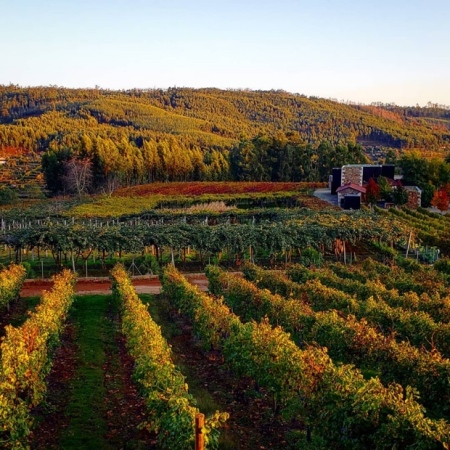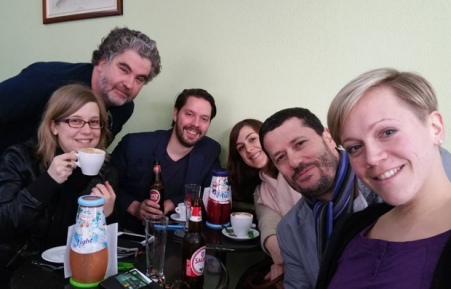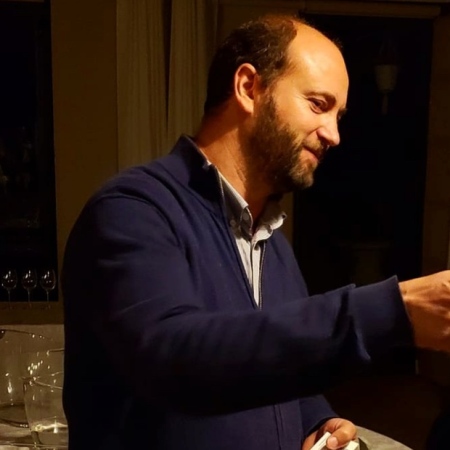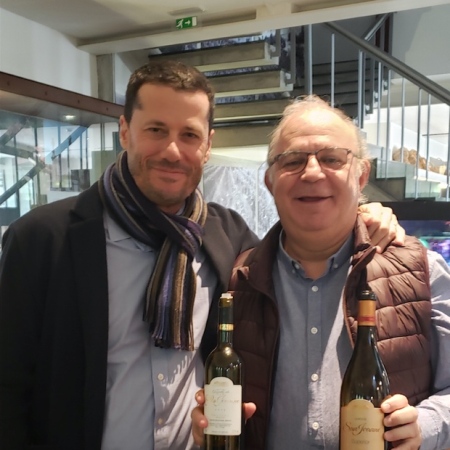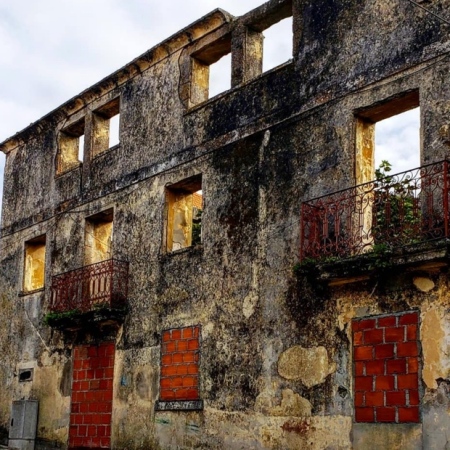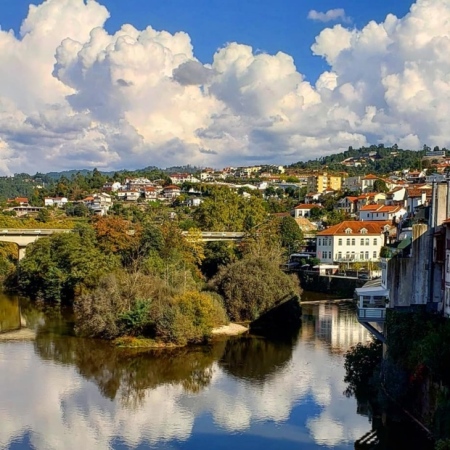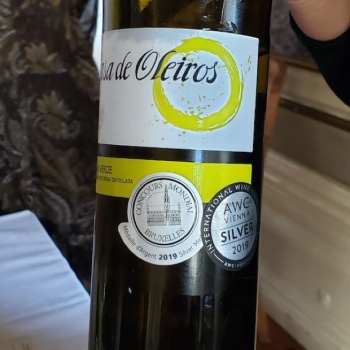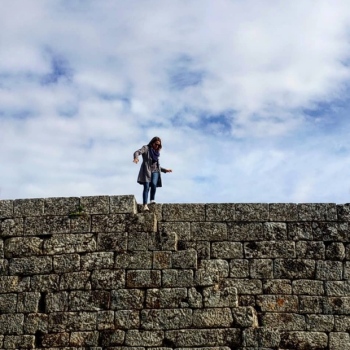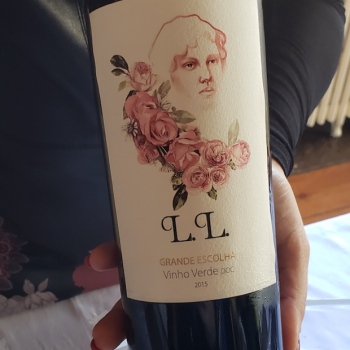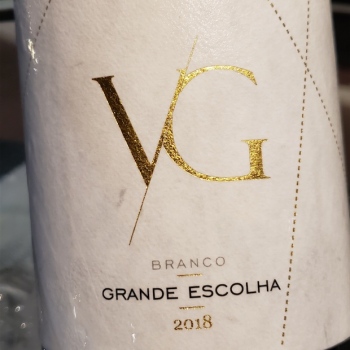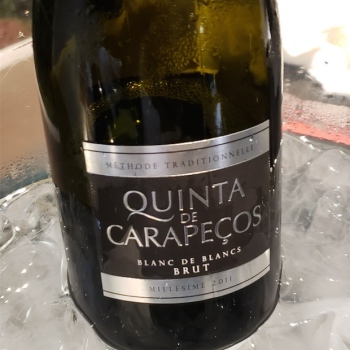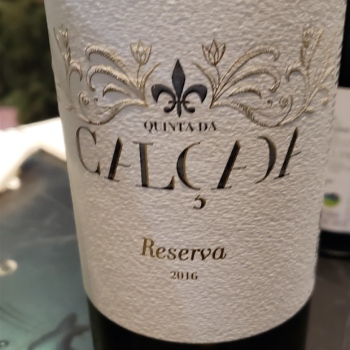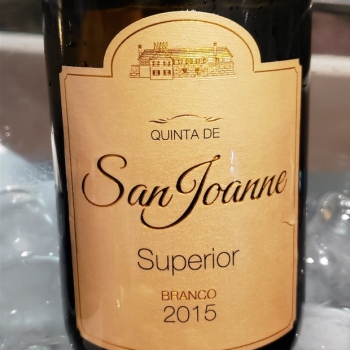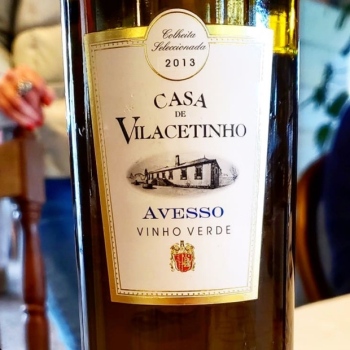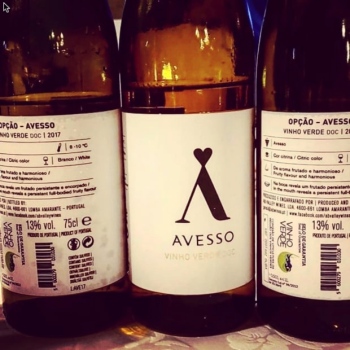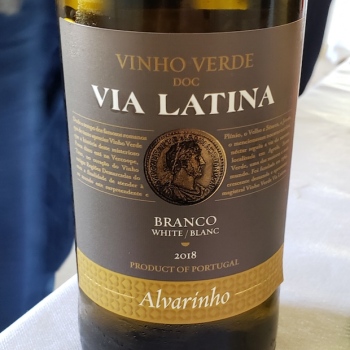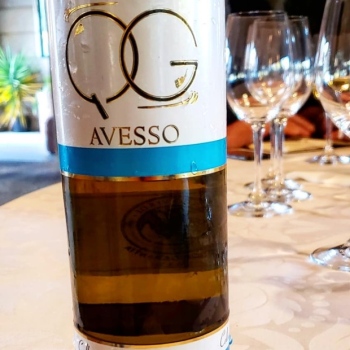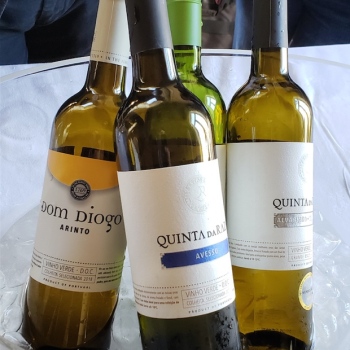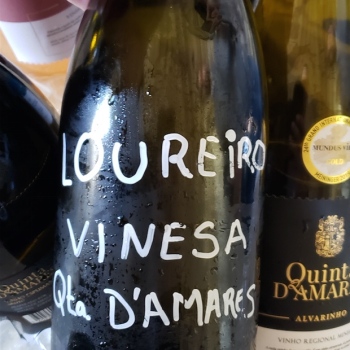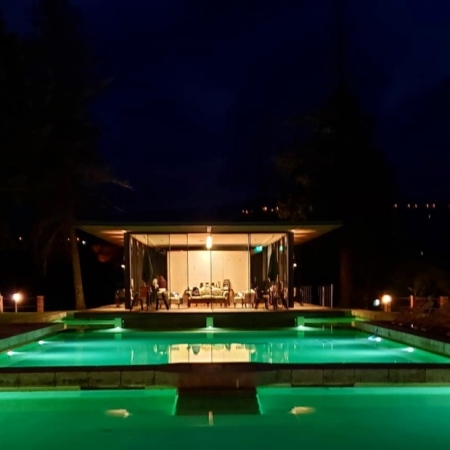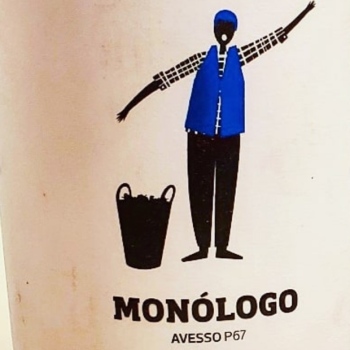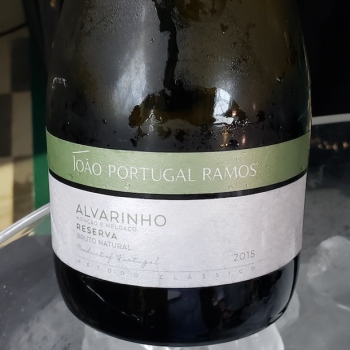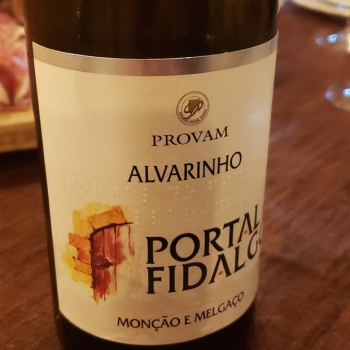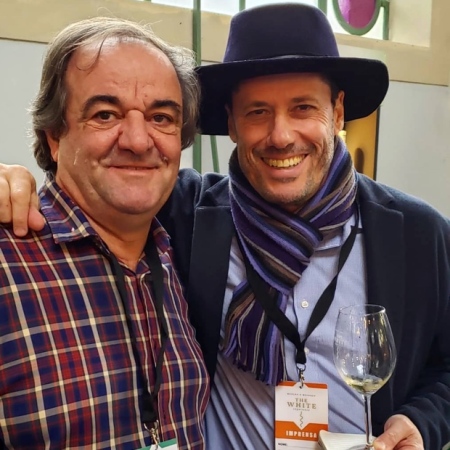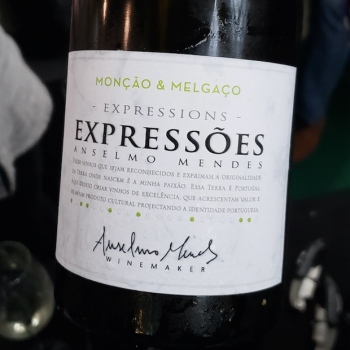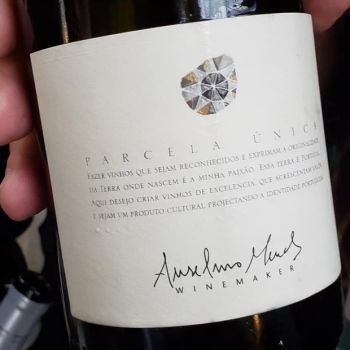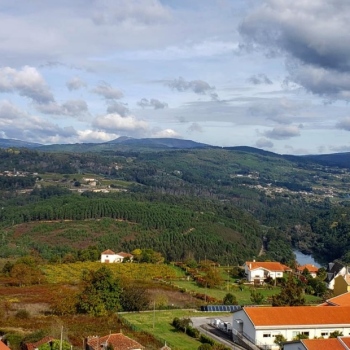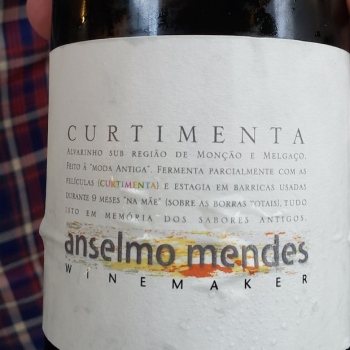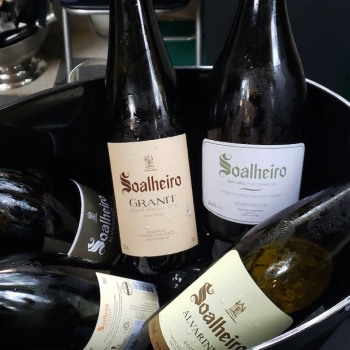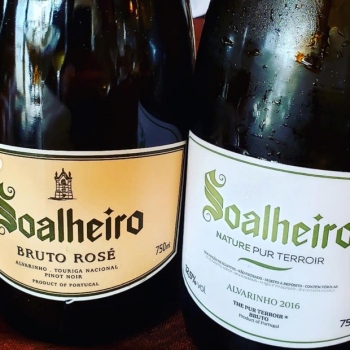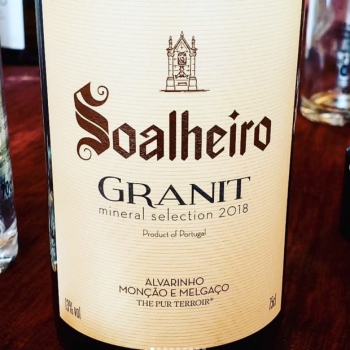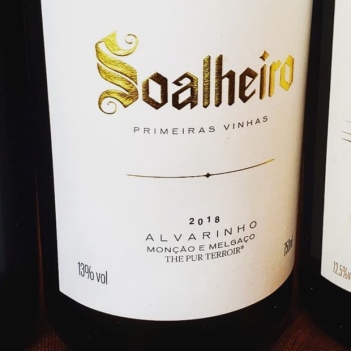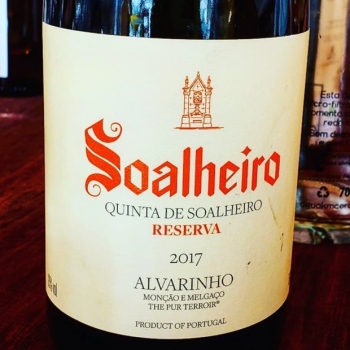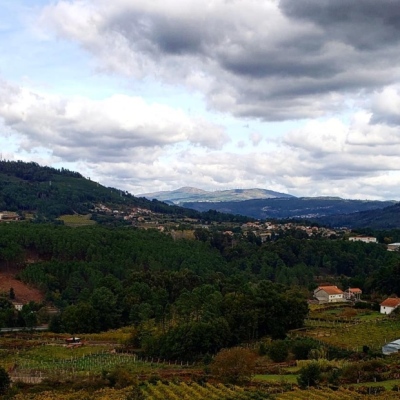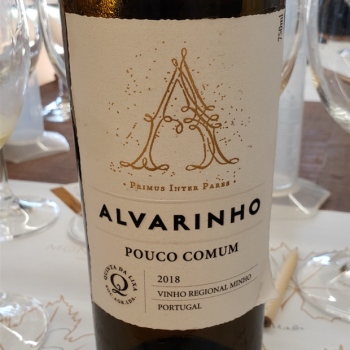Special Report on Vinho Verde
The rise of varietal Vinho Verde
By Michael Godel
Vinho Verde does not mean “green wine.” That idea just needs to cease making the rounds, both in essayed circulation and in conversation. Sharing the idea of O Verde e Leve on the other hand is to be endorsed. “Green And Light.” To “green-light” is to give permission, to go ahead or to move forward with a project. The term is a reference to the traffic signal, indicating “advance.” Lorde knows the haya is about being there, breathing, modestly, living life. “I’m waiting for it, that green light, I want it.” What we want is the green fields and the bright light found within and about Vinho Verde. We know it and we want it bad.
For a Vinho Verde primer and a look back at my March 2016 visit please read:
Related – I will always raise my glass of Vinho Verde to Le Sommelier Fou

On the border between Baião and the Douro you may come to a place that imagination could not have created. It is #quintadedantateresa and it is breathtaking. The home of A & D Wines.
Vinho Verde is in so many respects no longer simply a matter of white wine blends mired in the young, restless and simple. Was it ever? Sure the light fizz of residual co2 and straight-lined, neutral citrus in some of the world’s most inexpensive whites deservedly ingratiated itself as the darling of the urban, white-collar working class. Sure the basics were accessible to all and yes the party line repeatedly spoke of freshness. “The wines of Vinho Verde have long been known for their vibrant fruit, low alcohol and refreshing qualities.” Sure the appellation suggests that the wines are made from the combination of carefully selected grape varieties, namely alvarinho, avesso, azal, arinto, loureiro, and trajadura. While that much remains the truth something stirs in the northwestern Portuguese territory. It’s something varietal and the veering is not contained to the already considered denominação de origem wine that is soon to be recognized with its own DOC appellation. No, the varietal trending in Vinho Verde is not merely just a matter of alvarinho.
Much new ado about Avesso
Let’s talk about Avesso. Going vertical and horizontal with solo work all over Vinho Verde included a round table discussion with agronomist/oenologist/winemaker extraordinaire António Sousa at Amândio Galhano Wine Centre (EVAG). Sousa is in his 20th year making wine in Vinho Verde. He leads a wild pack of Canadians down an avesso rabbit hole. “Two hottest years are 2011 and 2017, 2019 a regular year,” he begins. “From Spain we never have good winds, or marriages.” Winds from there or from the south mean dry and hot seasons. And in the winter, frost and black ice. When from the sea it’s proper, normal, the best. May is the early season key; needs to be dry and warming so that both quality and quantity will be high. 2019 had some freezing rain so quantity was down 10-15 per cent, as compared to 2018. Sousa gets down to the varietal business at hand. No real clonal work has been done on Avesso, not yet and needs to be. All the plantings are massal selection with several clones though no real decisions on which and where have been done. A variety with less malic acid than others, more tartaric than malic but also less than azal (as a comparison) and more salinity. Avesso is the future.
João Pedro d’Araujo of Casa De San Joanne in Amarante notes that avesso’s canopy must be managed or it will burn. The grape variety is also susceptible to odium so the canopy must be managed for this as well, by creating an opened up, 3-D configuration to keep it aired out and dry. He keeps treatments to a minimum, hopefully to only four per growing season. In Basto Jose Diogo Teixeira Coelho of Quinta da Raza tells that avesso means “not how we want it but the other way around, or really, inside out.” At A & D Wines in the Baião sub-region on the border between Vinho Verde and the Douro is where Casa do Arrabalde, Quinta dos Espinhosos and Quinta de Santa Teresa explore varietal avesso (plus chardonnay and arinto) through the intense study of their Monólogo series. Fernando Moura is the oenologist behind these explorations at A&D Wines. At Quinta De Gomariz the intendment looks to age-ability for avesso in their Colheita Seleccionada and in the sub-region of Sousa there too is a focus on avesso by Quinta De Linhares. In Ave Vercoope trades varietal bottle blows with loureiro and alvarinho.
Varietal reduction is now very much alive, widely considered and rampant in Vinho Verde. Casa De Oleiros goes at the oeuvre in Amarante sub-region with arinto and azal while Casa De Vilacetinho does the same with avesso, as does António Sousa under his oenologist’s hat with Quintas De Caíz and his very own AB Wines. In the sub-region of Cávado loureiro is the varietal darling of Quinta d’Amares as it is in Sousa for Aveleda. The most famous of Vinho Verde producers also looks at alvarinho for solo measures but it is the northerly sub-region of Monçao e Melgaço along the Minho River where that most known VV variety receives the greatest attention. That is evident none more so than through the diverse verging on obsessive lenses of Soalheiro and Anselmo Mendes.
“Vinho Verde is Portugal’s largest wine region, with 19,000 grape growers farming over 51,000 acres of vineyards. 600 wine bottlers produce approximately 85 million liters of Vinho Verde each year, of which 86% is white wine. The region also produces smaller amounts of red, rosé and sparkling wine as well as brandy. It’s Portugal’s northernmost wine producing region located on the west coast of the Iberian Peninsula in northern Portugal. With its proximity to the Atlantic, the Vinho Verde region resembles Vancouver or Seattle in appearance with its lush, green landscape and temperature climate.” In October of 2019 I tasted and reviewed 75 examples of Vinho Verde DOC, Vinho Regional Minho and the artist still affectionately known as Monção E Melgaço A Origem DO Alvarinho. Here are the notes sub-divided by sub-region.
Sub-Region: Amarante
Casa De Oleiros “VV” 2018, DOC Vinho Verde
From the sub-region of Amarante where the grapes grown are arinto and azal. The light and most crisp blend is done up in 70-30 proportion from winemaker Jorge Sousa Pinto. Minty and juiced by lime cordial. So clean, basic and correct. Drink 2019-2020. Tasted October 2019
Casa De Oleiros 2018, DOC Vinho Verde
Varietal azal dry and intense, very citrus, lemon and also lime. A very clean expression, crisp and sharp. Just a minor bitter pith finish. Good length for VV. Drink 2019-2020. Tasted October 2019
Casa De Oleiros Vinho Pedernãl 2018, DOC Vinho Verde
Varietal arinto fom Amarante, more fruit than the azal but also a liquor or alcohol feel in the way of viognier. Almost tropical but still grounded by great verdancy. A richer, deeper and bigger VV with a repeat of that pith note on the finish. Drink 2019-2020. Tasted October 2019
Casa De Oleiros “LL” Grand Escolha 2015, DOC Vinho Verde
The premium wine, aged partially in barrel, a blend of azal and arinto with here 10 per cent alvarinho. Developed and metallic, big fruit and certainly wood notable. Pears meet mangos in a creamy and alloy mix, with that viognier almond bitter note that’s really uncanny. Drink 2019-2022. Tasted October 2019
Quintas De Vila Garcia VG Branco Grande Escolha 2018, DOC Vinho Verde
A blend of azal and arinto from a house that goes back 18 generations of producing wine. Only 2,000 bottles produced. Crisp, strikingly fresh, linear, all citrus, right at you, no holds barred. Grape spirit intensity, white lightning, tannic and grippy. Drink 2019-2022. Tasted October 2019
Quinta De Carapeços Blanc De Blancs Millesimé Brut 2011, DOC Vinho Verde
Varietal alvarinho and disgorged in 2016 after approximately five years on the lees. Some oxidative notes in the form of ginger and savoury brûlée yet conversely full of energy and drive. Preserved lemon and the not unexpected greatness of length. Drink 2019-2021. Tasted October 2019
Quinta Da Calçada Reserva 2016, DOC Vinho Verde
Made from mostly alvarinho, with arinto and loureiro. Trying to show the age possibility in ability of a vinho verde wine from Amarante. Decidedly cheese rind musky and sour. This bottle is past its prime and showing its faults. Drink 2019. Tasted October 2019
Casa De San Joanne Superior Branco 2015, DOC Vinho Verde
Made from malvasia (from only 0.3 hectares) and alvarinho for a most unique white out of Amarante. Made by João Pedro d’Araujo and so beautifully musky, orange scraped, crisp and full of vinous grape spirit. Plenty of persistent energy and implosive intensity. Wrapped so tight and you are so aware of how much purpose went into creating a blend that so distinctly distills the place out of which it came. Drink 2019-2023. Tasted October 2019
Quinta De San Joanne Escolha Branco 2004, Vinho Regional Minho
Labeled as such and a full 10 years later is when Joāo will be asked to come into (or back) to the appellation and so he now adds Vinho Verde to the back label. Here 14 years forward there is still a solid core of acidity keeping a buoyancy of fruit, as preserved lemon and waxy as it is. There is indeed an aged riesling character to this but making such a simple comparison is neither correct nor does it do any real justice to the age ability of this wine. That said it’s more Rheinhessen than Pfalz, having a meeting with the Peloponnese. Lovely salty finish. Drink 2019-2021. Tasted October 2019
Casa De Vilacetinho Avesso 2013, DOC Vinho Verde
Located in Amarante at 500m between two rivers, the Douro and the Vilacetinho and vines between 25-40 years old. No flint or matchstick but certainly age apparent. Strikes as being in delivery of all the proper Avesso components from age. Flinty and savoury, fruit stable and acids in tow. Still a pulse and freshness, still enervating. Very fresh for 2013. Drink 2019-2020. Tasted October 2019
Quintas De Caíz Encostas De Caíz Grande Escolha 2015, DOC Vinho Verde
An Amarante vineyard very close (50m) to the Tâmega River, planted in 2007 by winemaker/oenologist António Sousa, considered the best Avesso of the region from 2015. Extremely fresh and alive, verdant with the best of them and in the best ways. Lemon, lime and torched orange, right in the secondary zone with perfect entry, empathy and closing remarks. Drink 2019-2021. Tasted October 2019
AB Wines Opçāo Avesso “A” 2018, DOC Vinho Verde
From winemaker/oenologist António Sousa personal label (with partner Bernardo) and a vineyard planted in 2003, in Amarante. These are grapes just a few years away from what he considers the optimum age, when they reach 18 years, 10 years older than the age from which they begin to deliver excellence. Like it’s still fresh from the tank, without the complexity, or at least yet. The citrus is lean and not yet developed and the flesh not having come about. Underlined however by some of Vinho Verde’s most mature and knowing acidity. Not to mention the right grape for the exact place. “A” is for avesso, in Amrante. A work in progress. Drink 2019-2026. Tasted October 2019
AB Wines Opçāo Avesso “A” 2017, DOC Vinho Verde
From winemaker/oenologist António Sousa personal label (with partner Bernardo) and a vineyard planted in 2003, in Amarante. These are grapes just a few years away from what he considers the optimum age, when they reach 18 years, 10 years older than the age from which they begin to deliver excellence. Still very fresh and yet the warmth of 2017 brings more flesh, more orange, more creamy consistency though you would never consider these wines to be just that. Really solid avesso with texture, confidence and persistence. Drink 2019-2023. Tasted October 2019
AB Wines Opçāo Avesso “A” 2016, DOC Vinho Verde
From winemaker/oenologist António Sousa’s personal label (with partner Bernardo) and a vineyard planted in 2003, in Amarante. These are avesso grapes just a few years away from what António considers the optimum age, when they reach 18 years, 10 years older than the age from which they begin to deliver excellence. This A is in position A, from a perfect vantage point out of a very good vintage. This is the role model and exemplar for avesso, from a project that began in 2016, with all the adjunct components in line; lemon, lime, orange, ripe acidity, juicy nature and just a minor creamy, fleshy and boozy happiness. Great balance. Drink 2019-2025. Tasted October 2019
AB Wines Opçāo Avesso 1 Branco White Estagio Em Barricas/Aged In Barrels 2016, DOC Vinho Verde
From winemaker/oenologist António Sousa personal label (with partner Bernardo) and a vineyard planted in 2003, in Amarante. These are grapes just a few years away from what he considers the optimum age, when they reach 18 years, 10 years older than the age from which they begin to deliver excellence. Here avesso done in barrel (100 per cent new), for six months, the same vineyards and the same wine, but with wood influence though with António it seems it’s just a matter of shits and giggles. Handles the wood quite well and truth be told the subsequent vintages will be more to his liking and taste because he prefers using older wood. In fact the barrel usage is just another way with the grapes being the most important part of the process. Freshness ensured (with help from reductive winemaking processes), balance achieved and creativity instilled make for a result all in, together, as one. Covers the grape just a bit but not so much as to alter consciousness. Tasted from magnum. Drink 2019-2026. c Tasted October 2019
Sub-Region: Ave
Vercoope Via Latina Loureiro 2018, DOC Vinho Verde
Cooperative produced, old school waxy, floral, slightly spritzy and all about the fresh lemon notes. Has some texture for Loureiro but ultimately a VV of quick spurts and flavours. Drink 2019. Tasted October 2019
Vercoope Via Latina Alvarinho 2018, DOC Vinho Verde
Cooperative produced, the light and basic alvarinho, simple notes that are fruit forward and floral. Just a bit metallic and pithy. Drink 2019. Tasted October 2019
Vercoope Via Latina Rosado Pavão 2018, DOC Vinho Verde
A blend based on espadeiro but also vinhao and other red grapes used for Vinho Verde Rosé. Quite spritzy and surely augmented by CO2. Old school for trends and new markets. Soapy finish. Drink 2019. Tasted October 2019
Via Latina De Espumante 2018, DOC Vinho Verde
Varietal espadeiro, this time in sparkling Rosé form with a healthy dosage and maximum CO2. Simple, strawberry fruited and easy. Drink 2019. Tasted October 2019
Quinta De Gomariz Avesso Colheita Seleccionada 2011, Doc Vinho Verde
From vines planted in in 2008, in the sub-region of Ave. Is there a similarity to encruzado here? Perhaps and here with a flinty matchstick note that shares the affinity and in the way of sémillon but perhaps even more so roditis from the Peloponnese. Clearly verdant and savoury, even a lime sherbet moment. Not really enough acid left but still hanging on. Slight bitter pith finish. Drink 2019. Tasted October 2019.
Sub-Region: Basto
Quinta Da Raza 2018, DOC Vinho Verde
The blend breaks down to 35/50/15, of a very traditional mix in azal/arinto/trajadura. Lemon juicy, mineral granite tight (arinto), schisty fresh (azal) and rich from clay (trajadura). Acidity and a sweet fruit finish. Drink 2019-2021. Tasted October 2019
Quinta Da Raza Dom Diogo Arinto 2018, DOC Vinho Verde
Varietal arinto which brings a peach-mint-pear-mango fullness. Brings the varietal to the people and shows how much flavour and texture it is capable of developing. Drink 2019-2021. Tasted October 2019
Quinta Da Raza Avesso Alvarinho 2018, DOC Vinho Verde
Shows the continued affection for avesso and continues the aromatic profile of the house, jumping from the glass and here with alvarinho, also the fleshy texture. Some sweetness and pulse, even a bit of CO2. Drink 2019-2021. Tasted October 2019
Quinta Da Raza Avesso 2018, DOC Vinho Verde
Avesso means “not how we want it but the other way around, or really, inside out.” Thrives in this micro-climate, sandwiched in the saddle of a valley between two mountains, one protecting from Atlantic winds and the other to the southeast towards the Douro Valley. This grape needs dry conditions and more heat, provided here and so it comes out stony, tart, tight, sapid and far from fruity. Clean, crisp and honestly avesso, clearly the calling card of Raza. Drink 2019-2023. Tasted October 2019
Sub-Region: Cávado
Quinta d’Amares Rosé 2018, DOC Vinho Verde
A light, airy and delicate Rosado, of guava and strawberry design. Salty and suave, proper and finishing with just a hit of Campari. Really righteous. Drink 2019-2020. Tasted October 2019
Quinta d’Amares Loureiro 2018, DOC Vinho Verde
Varietal Loureiro, flagship for the sub-region, full of fresh flowers and yellow citrus, almost muscat in organoleptic properties. Quite classic, proper, clean and musky. Could only be Loureiro. From vines 15-20 years of age grown in the valley, protected buy mountains with warm days and cool nights. A truly solid loureiro with grip and confidence. This does it right, made for a sense of place. Drink 2019-2022. Tasted October 2019
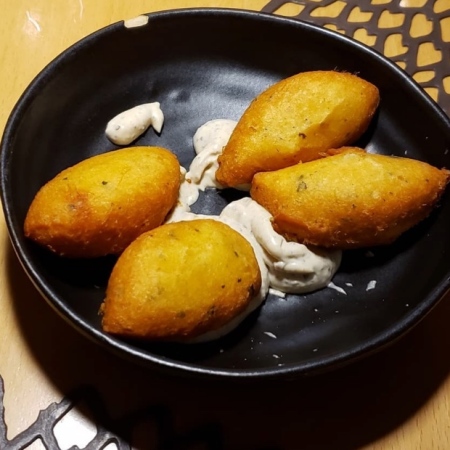
f you are ever in Porto do yourself a personal solid and get to @bbgourmetporto for an unforgettable culinary and @vinhoverdewines experience.
Quinta d’Amares Alvarinho 2018, DOC Vinho Verde
From an area that transitions away from non-alvarinho territory into another that truly represents it. This place of twain planted it and sees its potential, exemplified in the glass. Not so structured but also not messed with there’s a delicacy and a florality so if a compromise, so be it. Done right. Drink 2019-2021. Tasted October 2019
Quinta d’Amares Vino Espumante Bruto 2018, DOC Vinho Verde
Sparkling made from varietal arinto, youthful, aggressive, tonic injected, fresh and aromatically like wet concrete. The mousse expands and delivers some almond skin, bus also the pit. That’s the balance to offset the creaminess and the lees. Morphs with time and gets into lime-doused peach. Sweetness (6 g/L) is easily offset buy the complex character. Drink 2019-2021. Tasted October 2019
Quinta d’Amares Loureiro Vinessa 2018, DOC Vinho Verde
Vinified like a red wine, essentially orange though only 6-7 days of fermentative contact. More texture and aromatics, orange and lime, gems and metals. Almost oily. Drink 2019-2021. Tasted October 2019
Sub-Region: Baião
A & D Wines Casa Do Arrabalde 2018, DOC Vinho Verde
From Quinta de Santa Teresa, a field blend of three A’s, avesso, alvarinho and arinto, grown at 490m and co-fermented. A blend bringing all the VV components together; aromatic florals, fleshy texture and tangy acidity. Native yeasts are used, the winery is in conversion to organic and the ideals are minimalist, including sulphur usage. Drink 2019-2021. Tasted October 2019
A & D Wines Quinta Dos Espinhos 2018, DO Regional Minho
A 50-50 blend of avesso and chardonnay grown at 450m. Like the Vinho Verde field blend made with local varieties the soil sources are granitic in origin to give this a straight shooting stony feel. There’s a green apple bite and very linear acidity. Just a touch of bitters to finish. Drink 2019-2021. Tasted October 2019
A & D Monólogo Arinto P24 2018, DOC Vinho Verde
Quinta de Santa Teresa is the sub-region of Baião estate that delivers a warmer arinto then many in the region, organic and planted at 320m, in parcel 24. Richer, fuller and fleshier than most with yellow and green fruit, sapidity and bite. A very refined wine, also polished and long. Drink 2019-2022. Tasted October 2019
A & D Wines Singular 2018, DOC Vinho Verde
A field blend, planted together; arinto, avesso, alvarinho, etc. but this time fermented with some barrel and treated to bâtonnage. The main varietal play is avesso but the idea here is to blend from field to table. The oldest estate vines at Quinta de Santa Teresa bring structure and ageing possibility to this wine. Metals and metallics join tang, sapidity and more tang. Drink 2019-2023. Tasted October 2019
A & D Wines Monólogo Avesso P67 2018, DOC Vinho Verde
One variety and one parcel (P67) do the talking in this solo effort. The organic vines are at 460m and this may just be the most important single variety, notably because the salinity and sapidity really take over to subdue the metallics and the tonics. Again great polish and effect. Drink 2019-2024. Tasted October 2019
A & D Wines Monólogo Chardonnay P706 2018, Vinho Regional Minho
It may be chardonnay but clearly the granite of Baião can’t help but dole out the local character. The infiltration is uncanny, recognizable and not possible to be discounted. It’s a spicy bite of a green apple and crunchy stone. Goes to prove you can plant chardonnay at Quinta de Santa Teresa but you can’t take Santa Teresa out of the chardonnay. Drink 2019-2022. Tasted October 2019
A & D Wines Espinhosos 2009, Vinho Regional Minho
First vintage of chardonnay with a pinch of alvarinho and bottled with a helluva whole lotta lees. Now really, really pineapple, a glazed one, caramelized, buttery and creamy. Coppery with a steep of orange pekoe and a hit of jasmine. Curious, complex and in the denouement of its life. Drink 2019-2020. Tasted October 2019
Sub-Region: Monção E Melgaço
Encostas Da Capela Alvarinho 2017, DOC Vinho Verde
Nothing else in the world smells like alvarinho from Reguiero on terraces between 150-300m on granite soils. Salty, citrus, sapid and herbal but singular, unique and one of the most unheralded white wines in the world. Drink 2019-2023. Tasted October 2019
João Portugal Ramos Alvarinho 2018, DOC Vinho Verde
From one of Portugal’s most industrious, innovative and prolific producers here is Vinho Verde with an alvarinho that’s as crisp, fresh and clean as you are likely to find. Ideal sourcing and execution from Monção and Melgaço. Stunning acidity and ultimately stunned by acidity. Drink 2019-2021. Tasted October 2019
João Portugal Ramos Alvarinho Reserva 2017, DOC Vinho Verde
There are some who consider João Portugal Ramos to be the Piero Antinori of Portugal and who’s to argue when you consider the sheer professional breadth of production, including this barrel fermented alvarinho from Monção and Melgaço. The wine spent 10 months in French barrels to emerge buttery, green apple in notation and expertly tugged between rich and sharp. Like chardonnay produced in an old world diaspora location with endemic varietal independence. Drink 2020-2024. Tasted October 2019
Provam Porta Fidalgo Alvarinho 2017, DOC Vinho Verde
Porta Fidalgo is 100 per cent Alvarinho from Monção e Melgaço with as much a fruit compliment as you are likely to find anywhere in the alvarinho sub-region. The tropical warmth meshes nicely with an abundance of energy and the expectation met by a granite-mineral profile. Well-made Vinho Verde. Drink 2019-2020. Tasted October 2019
Provam Contradição Alvarinho 2017, DOC Vinho Verde
Contradição is alvarinho made as in the old times with new technologies. A contradiction with tradition, so to speak. Takes the fruit substance from Porta Fildalgo and runs with it, accentuated the concentration, richness and fulness. Still maintains a credible mineral salt opposition and supposition so that balance in posit tug is afforded. High-end alvarinho in Melgaço-Vinho Verde clothing. Drink 2020-2026. Tasted October 2019
Provam Porta Fidalgo Alvarinho Reserva 25 Anos 2015, DOC Vinho Verde
Provam constitutes 10 wine-growers of the sub-region of Monção e Melgaço and 25 per cent of their grapes come from the vineyards of the partners with the remainder purchased through other growers. The reserva is made like a red in that it sees 12 days on skins to result in this great floral alvarinho. While the hue suggests mystery the wine is perfectly crisp and clean. Where it varies and veers is on the salve-like, melting pastille textured palate to bring it into the not so mysterious natural realm. Lots of orange skin and certainly a departure for the territory and the sort of producer who’s chosen the route. Very well made, smart and almost cheeky Vinho Verde. Drink 2019-2021. Tasted October 2019
Poema Alvarinho 2007, DOC Vinho Verde
Poema is aged for 24 months with its fine lees in small inox barrels plus 12 further months in the bottle. This 12 years later is conceptually lovely though clearly deep into oxidative times. Chamomile flowers and bee pollen make for great curiosity and interest even in the absence of citrus and acidity. Drink 2019. Tasted October 2019
Anselmo Mendes Muros Antigos 2018, DOC Vinho Verde (112245, $13.95)
The blend is generally loureiro, avesso and alvarinho, combined to represent Anselmo Mendes’ traditional Vinho Verde range of both varietal wines and blends. These are vineyards lining the Lima River, four months on lees with batônnage, here from a balanced vintage between fruit and acidity. All the varietal soldiers are in line, straight, sapid, Atlantic-influenced and salty as ever. Drink 2019-2022. Tasted October 2019
Anselmo Mendes Contacto Alvarinho 2018, DOC Vinho Verde (393058, $19.95)
Contacto is varietal alvarinho from alluvial terraces filled with pebbles, stones and clay. It’s one of the many experimental wines that Anselmo Mendes dabbles with and from varied soils, for variation and exploration in the varietal world of Monçao é Melgaço. Suggestive in name for 12 hours skin contact to go along with the estate’s main number, that being four months lees plus batônnage. Contacto may be regulated but what it most certainly is is rich, stylish and internally variegated. A developed texture raises the mousse-like bar and thus the mineral salts are swirled in to become part of the profile. High flavour and very distracting of an alvarinho with a wry smile. Drink 2020-2024. Tasted October 2019
Anselmo Mendes Muros De Melgaço 2018, DOC Vinho Verde
The first vintage for the Muros de Melgaço label was 1998 and the nose tells you straight away this is northern Minho issue so apposite to what comes from out of the Lima River Valley. Saline in a very different way, more soil-derived, from granites and alluvial terrace more so than from Atlantic Ocean marine influence. The rock-land-mineral sway is citric and sharp, lemon, lime and steely. There are more furthered layers yet to peel away and reveal the texture hidden beneath the crust. The real deal for Melgaço without too much experimentation for purists who relish the linear and direct alvarinho. Drink 2021-2026. Tasted October 2019
Anselmo Mendes Expressões Alvarinho Branco 2017, DOC Vinho Verde
Expressões is an apt moniker for an alvarinho that is an expression of deep Melgaço gravelly soils. Anselmo gives it the respect it deserves and requires, sent for six months to used French barriques (225 and 400L 5-10ish years old) on the lees with generous batônnage. There simply are no other versions of alvarinho in the region that combine soils and acumen like this Expressões. Always the one that amalgamates hue, tonic, grain and texture, exaggerated here in the basking warmth of 2017 with furthered vision, layers and spirit. It almost seems too much this time around but there is no questioning the quality and the impression it leaves. Drink 2020-2025. Tasted October 2019
Anselmo Mendes Parcela Única Alvarinho 2017, Doc Vinho Verde
Parcela Única deals with single-parcel, investigative expressiveness from and for alvarinho with similar treatment to the Curtimenta, that is for nine months and here in new (400L) French barriques. Always on the lees with batônnage as per the Mendes way. The most premium block of alvarinho on a granite terrace in Monção and Melgaço is in the “monk’s area” where Anselmo feels the possibility is that of elegance and exceptionality. This is without a doubt the richest and most boisterous alvarinho in the land with 2017 compounding the effect and so patience will only be required if you’d like to drink a bronzed, Napa style chardonnay a few years down the road. This ’17 would serve best in its first few winters alongside a scene set in respite, calm and with great company. Drink 2020-2022. Tasted October 2019
Anselmo Mendes Parcela Única Alvarinho 2012, Doc Vinho Verde
Tasted 31 months later this singular alvarinho is very much a drawn butter specimen like a wise and creamy chardonnay from Beaune to Oakville with a granite twist. Drinking in its wheelhouse and will do so for two more seasons. Last tasted October 2019
One year makes all the difference. The new wood (400L, nine months) has melted, tempered and now oozes in flavour. The texture is butyraceous, bled, like a creamy foam that begins to lose its air. This is the hedonism that rises above the rest. It is the most internationally-styled, Burgundy to Napa simulacrum. Flirty alvarinho from Monção and Melgaço. Drink 2017-2022. Tasted March 2016
Anselmo Mendes Curtimenta Alvarinho 2016, DOC Vinho Verde
Anselmo Mendes goes all in for all out texture in this Minho River, granite terraces on hillsides expression of alvarinho. The formidable skins remain in contact for 10-12 days followed by a heightening for nine months in used French barriques (225 and 400L 4-10 years old) on the lees with batônnage. Curtimenta literally means “bronzing,” or figuratively as “connecting with the vineyard’s soil composition to make yellow stone jam.” All about texture really, as per the Mendes oeuvre. Top quality vintage for this ambitious and singular alvarinho. Drink 2021-2028. Tasted October 2019
Anselmo Mendes Parcela Vinha De Capela 2017, DOC Vinho Verde
Only five barriques are filled with this alvarinho from porphyry granite on hillside terraces in Melgaço. Large-grained quartz crystals are the ulterior textural source from this particular parcel of igneous rock that can’t help but bring part of the crunchy texture to an otherwise creamy and caramelized alvarinho. Flavours run the gamut through pith, tonic, bitters and in the end a startling streak of necessary acidity. Wild wine this one. Drink 2020-2026. Tasted October 2019
Anselmo Mendes Tempo 2015, DOC Vinho Verde
Tempo is Anselmo Mendes’ full-on experiment, skin-contact maceration, induced carbonic gone for broke, 100 per cent malolactic alvarinho. An experiential convene is afforded from which oxidation and acidity meet at a frenetic pace in a void and at a vortex occupied by the unusual and the exhilarating. Nothing else acts or speaks like this alvarinho. Drink 2021-2027. Tasted October 2019
Soalheiro Alvarinho Nature Pur Terroir 2016, Monção E Melgaço A Origem DO Alvarinho
Ancestral method, malo allowed, no sulphites natural sparkling wine. It is out of the box indeed, at least for Melgaço and the Minho lands of Vinho Verde. So bloody yeasty and funky preserved lemon but at the top of its character is a crunchy golden toast you will not find anywhere else nearby. Pretty singular and blessed of the natural in epitome imagined. Drink 2019-2021. Tasted October 2019
Soalheiro Alvarinho Bruto, Monção E Melgaço A Origem DO Alvarinho
Made from 100 per cent alvarinho for all times, including breakfast. Just like alvarinho; fresh, lemon scented, floral and textured. Simple, plenty of fruit and all about youthful energy. Drink 2019-2020. Tasted October 2019
Soalheiro Alvarinho Bruto Rosé, Monção E Melgaço A Origem DO Alvarinho
A blend of alvarinho, touriga nacional and pinot noir. The red grapes bring a rustic and rusty feel, suppressing the alvarinho but also lifting or being lifted by the sweetness. These are not trying to be Champagne and there’s no real presence of brioche or toasted bread. The fruit mix makes for a raspberry, plum and cream conglomerate. Good acids and energy balance the sugars. Drink 2019-2020. Tasted October 2019
Soalheiro Alvarinho Clássico/Classic 2018, DOC Vinho Verde
Produced from the most aromatic grapes found in the valley by the Minho River, on soils of decomposed granite sand. The dictionary entry for alvarinho and Melgaço, direct, full on tang spirit, fleshy and very lemon. Speaks on behalf of fruity wines with great local prejudice. Drink 2019-2022. Tasted October 2019
Soalheiro Alvarinho Granit 2018, Monção E Melgaço A Origem DO Alvarinho
From vines grown up higher in the granite hills at 200m of altitude. Regular stirring and aging on the fine lees makes for a fuller expression of the local varietal champion and also extended with elastic stretch out of a reductive style. Brings more variegated sweetness, of lime, orange and something tropically exotic. All the while adhering to the rocks and faithfully instructing about the stones. Drink 2019-2023. Tasted October 2019
Soalheiro Alvarinho Primeiras Vinhas 2018, Monção E Melgaço A Origem DO Alvarinho
Made from the oldest, ungrafted revolutionary vines planted in 1974. The vines are in the twain, between the valley and the hills, at 100m give or take. Spent nine months in large cask. It’s a completely unique and singular aromatic alvarinho profile. It’s got all the herbs and tisane, dried orange peel and pinks sea salts. Direct in your face, mouth, mind and heart. Proper and will age beautifully. Drink 2019-2026. Tasted October 2019
Soalheiro Alvarinho & Pinot Noir Mineral Rosé 2018, The Pur Terroir
The self-professed swimming pool wine, light, salty, tart and simple. Straight from the bottle if you like and lighter than the 12.5 declared. Drink 2019-2020. Tasted October 2019
Soalheiro Sauvignon Blanc & Alvarinho 2018, Innovation And The Pur Terroir
The 70 per cent sauvignon blanc may just be the only grapes purchased and bottled in Melgaço and a packaged deal along with the no secret explanation expressed Soalheiro pinot noir acquisition. Tangy, tart, almost waxy, terpenic and very, very grassy. Plenty of refreshment and linearity from this unusual blend with alvarinho. Drink 2019-2020. Tasted October 2019
Soalheiro Reserva Alvarinho 2017, Monção E Melgaço A Origem DO Alvarinho
Talk about unusual and the passion. This barrique aged Reserva smells like all the herbs but also fennel and some sort of waxy polish. Buttery and creamy, orange brûlée, a hint of ginger and a mild capsicum. The local dictionary entry for Reserva. Drink 2019-2022. Tasted October 2019
Soalheiro Terramatter Alvarinho 2017, Vinho Regional Minho
Early harvested, partial malolactic and raising in chestnut barrels make for a slightly foggy, rich in texture, more sugary alvarinho. Tastes like 15-20 g/L of RS with mild but elevating acidity. Unfiltered, engaging for sure, experimental and a lovely creamy finish, marked by a spicy note and bitters. Drink 2019-2022. Tasted October 2019
Soalheiro Nature Alvarinho 2017, Monção E Melgaço A Origem DO Alvarinho
No sulphites are added to Soalheiro’s most natural wine and truth be told it’s a strict, crisp and clean example. Lemon in many ways, first juiced, then scraped and finally preserved. It’s textural in a crunchy way and really long. Not aggressive yet grippy, structured and carries some interesting aging potential. Drink 2019-2025. Tasted October 2019
Soalheiro Oppaco Vinhāo Alvarinho Pinot Noir 2017, Vinho Regional Minho
A co-fermented mix of 70 per cent vinhão with (white) alvarinho and pinot noir with less tannic thrush than normal but to be sure the volatile tonality is pretty high as a result. Reminds me of Bourgogne AOC in the most wide-ranging regional form with its tension and grip. Cherries, earth and acids. It’s what you know and understand with oak hidden in the back. Drink 2019-2021. Tasted October 2019
Sub-Region: Sousa
Quinta Da Lixa Pouco Comum Alvarinho 2018, Vinho Regional Minho (316968, $14.95)
Not common but rather unique, alvarinho as a solo artist from this part of Vinho Verde. Also not a DOC VV but a regional wine as Minho, though in 2019 the change will allow for VV to have such a DOC. This is the elevation of this revered territorial grape and here there’s a linearity and a direct response to the land. Straight ahead citrus and fine acidity. Drink 2019-2021. Tasted October 2019
Aveleda Casal Garcia Rosé NV, DOC Vinho Verde
A sugary Rosé conversely high in acid and pumped up with that classic residual Vinho Verde CO2. Sweet strawberry and cloying with joy. Utilitarian and only bottled when needed. Drink 2019-2021. Tasted October 2019
Aveleda Casal Garcia NV, DOC Vinho Verde
Though non-vintage it is considered the eightieth anniversary of the brand for the classic citrus, light, carefully controlled and blended varietal mix, balanced for a traditional profile set in a clean, crisp and clear modern world. C02 corrected, generous 11 g/L residual sugar left asserted and not wholly arrested in the ways of how the wine used to be. Made to please the consumer who wants a piece of what they’ve always known. Sweet peach and citric tablet finish. Notable sulphur and sterility from the filtration. Bottled as needed, like Prosecco. Drink 2019. Tasted October 2019
More sugar than the NV (here with 15 g/L) and very citrus tablet, like somewhere between lime and honeydew. Even more spritz and pulse than the Casal Garcia but clearly riper and more important fruit. Simple and timeless. Drink 2019. Tasted October 2019
Aveleda Colheita Selecionada Loureiro 2018, DOC Vinho Verde
A slightly drier Vinho Verde centred on the trend to bottle mono-varietal, here from the local loureiro. Very waxy, musky and citrus aromatic profile with an exact repetition to taste. Precise for the grape, expressive as expected and no frills. Drink 2019-2020. Tasted October 2019
Quinta Da Aveleda Loureiro Alvarinho 2018, DOC Vinho Verde
Bit of demure and muted aromatics with the two grapes vying for control and so they muffle and muzzle one another. Packs in flavour however in a much drier, linear and transparent wine with a 70-30 loureiro to alvarinho mix. Very lime driven and satisfying. Drink 2019-2021. Tasted October 2019
Aveleda Alvarinho Colheita Seleccion 2018, Vinho Regional Minho
A very interesting wine right here, of history and change with Aveleda at the lead of what will be. Next year the laws will change to allow sub-regions other than Monção and Melgaço to use 100 per cent alvarinho and label it Vinho Verde. Here not labeled Vinho Verde but will almost certainly be when the labelling legalities change. Others will want to join too. Meanwhile this dry and spirited white is the best they make in this brand. It has energy and texture, a peppery kick and a whole lot of soul. Drink 2019-2021. Tasted October 2019
From between Penafiel and Amarante and from vines around 20 years of age. Rain before and after harvest, and that was basically it. Good acid structure in this example, stable and really good bitters. There’s a seamlessness between fruit flavours, white peppery edginess and phenols appearing as pith and tonic. Highly curious and quite creamy with a white pepper gassy note at the finish. Drink 2019. Tasted October 2019
Quinta De Linhares Vinho Branco Avesso Colheita Seleccionada 2014, DOC Vinho Verde
The hardest variety to grow in the worst vintage in recent history and that’s because it rained so heavy in so short a time. There is such a thing as too much rain in Vinho Verde. There was definitely botrytis in 2014. You can taste it in the form of boozy fruits and clearly see it in hue as well. Beginning to act maderized, not grossly but yes the oxidative introduction to ensure early days freshness is now bringing about a quick turn to the other side. Still pleasurable but not for much longer. Drink 2019. Tasted October 2019
Vila Nova Reserva 2014, DOC Vinho Verde
Vineyards in Penafiel, neighbours to Linhares and here fermented in barrel. Definite oxidation mixed with the botrytis of 2014 though not having entered the world of maderization. Orange crème brûlée and preserved lemon. Saffron almost nearly covered up by oak. The tannins in the wood have protected the fruit from total disaster. Delivers some real charm as a result. Drink 2019. Tasted October 2019
Good to go!
godello
Twitter: @mgodello
Instagram: mgodello




